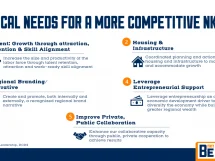6.6 million jobs added since end of recession
By Bob King
President, Kentucky Council on Postsecondary Education

FRANKFORT, Ky. (Jan. 5, 2016) — Since the Great Recession, the national press has communicated the notion that a college degree is not worth the effort or expense, and that few jobs exist for those who pursue this fruitless but costly adventure. Story after story has perpetuated the myth of deeply indebted college graduates wasting away in dead-end jobs paying minimum wages and receiving no benefits. All good storytelling, these emotional, compelling, heartrending tales lead to the savory conclusion that colleges and universities are selling products no one really needs. But a new report developed by the Center on Education and the Workforce at Georgetown University clearly demonstrates that all these stories are just that—stories. While the anecdotes may have been true, the larger data paints a very different picture.
Entitled “Good Jobs Are Back: College Graduates Are First in Line,” the study provides clear and compelling data dispelling the “no jobs for college grads” mythology that has become so popular across the nation. The report divides newly-created jobs in the economy into three categories: good jobs (paying more than $53,000); middle-wage jobs (paying between $32,000 and $53,000); and low-wage jobs (paying less than $32,000). The report tracks both the growth of the various types of jobs and who is filling them.
Of the 6.6 million jobs added during the recovery since the Great Recession, 2.9 million were in the good jobs category, and 2.8 million (97 percent) of those jobs were filled by people who had earned at least a bachelor’s degree. The good jobs constituted 44 percent of all the new jobs created, while low-wage jobs only constituted 27 percent of the new jobs created.
The vast majority of the good jobs were full-time, and 68 percent included health insurance and 61 percent included employer-sponsored retirement plans. In contrast, the low-wage jobs were nearly three times as likely to be part-time, only 33 percent included health insurance and only 25 percent provided a retirement plan.
The types of jobs included in the “good jobs” category include managerial positions, software developers, registered nurses, financial analysts, market researchers, computer-related occupations, as well as the STEM occupations (science, technology, engineering and mathematics) and the allied health professions. Many of the managerial and market research jobs were filled by people with degrees in what many would describe as the liberal arts.
Beyond this report, other data from the Bureau of Labor Statistics, Consumer Expenditure Survey demonstrate that for those who graduate, student-related debt levels are manageable, and that the percentage of income dedicated to loan repayment is comparable to average monthly expenditures on entertainment ($217), apparel ($145) and healthcare ($296).
So, Kentucky high school students and parents, stop believing all the horror stories so popular in the media. A bachelor’s degree is well worth the effort and the expense, and the world of employers out there is anxiously awaiting your arrival into the workforce as a highly-educated, highly-skilled contributor to their company’s success.




















Add Comment